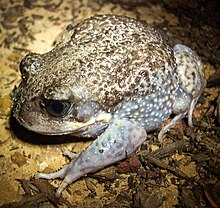Giant burrowing frog
| Giant burrowing frog | |
|---|---|
 |
|
| Scientific classification | |
| Kingdom: | Animalia |
| Phylum: | Chordata |
| Class: | Amphibia |
| Order: | Anura |
| Suborder: | Neobatrachia |
| Family: | Myobatrachidae |
| Subfamily: | Limnodynastinae |
| Genus: | Heleioporus |
| Species: | H. australiacus |
| Binomial name | |
|
Heleioporus australiacus (Shaw & Nodder, 1795) |
|
 |
|
| Range of the giant burrowing frog | |
The giant burrowing frog (Heleioporus australiacus) is a large frog species that occurs in coastal south east New South Wales and Victoria in Australia.
This is a large species of frog, up to 10 cm in length. It is normally grey, dark brown or black on the back. It is white on the belly. There are yellow spots on the side and a yellow stripe on the upper lip, from the back of the eye to the back of the tympanum. In metamorph frogs, this stripe is pink-orange in colour. The skin is rough and bumpy, males often have black spines on their fingers during the breeding season. This iris is silver and the pupil is vertical.
This species inhabits sandstone heathland, dry, and also wet sclerophyll forest from north of Sydney to eastern Victoria. They are called burrowing frogs because of their burrowing ability. They are also known as the eastern owl frog because of their mating call, which resembles the hooting of an owl. Males call from burrows on the edges of streams during autumn and spring after heavy rainfall. Eggs are laid in burrows on the shores of creeks and streams, to be washed into the water during heavy rainfall. The tadpoles develop in the creek and take 3–11 months. The tadpoles are very large in size, up to 80mm.
This is quite a large species of frog and the largest frog in Victoria. It is often mistaken for the cane toad because of its large size of 9 to 10 cm and bumpy skin; however, cane toads do not have vertical irises, and the range of the cane toad currently does not overlap into giant burrowing frog habitat.
These frogs can be seen sitting out on the edges of roads and walking tracks at night, after rain in areas of favourable habitat. This species has declined due to urbanisation and is mostly restricted to National Parks and State Forests.
...
Wikipedia

